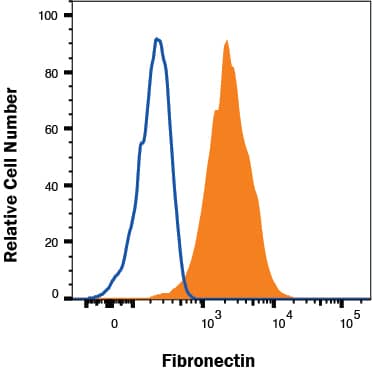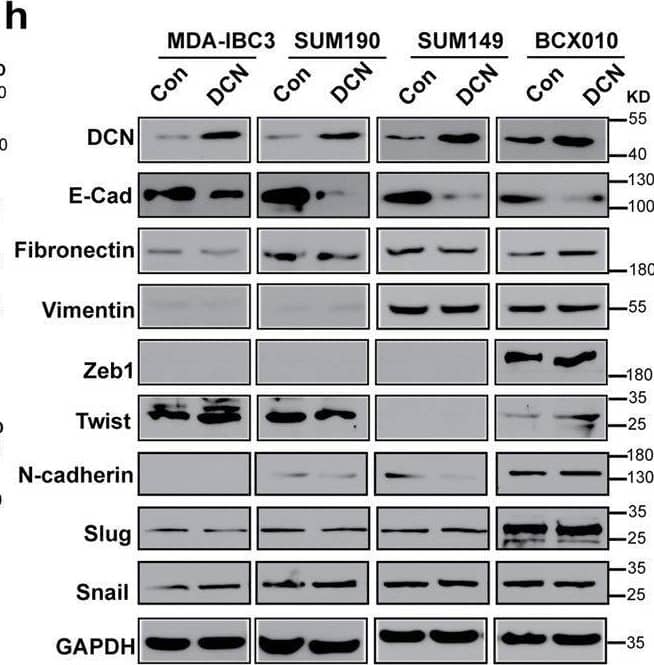Human Fibronectin Antibody Summary
*Small pack size (-SP) is supplied either lyophilized or as a 0.2 µm filtered solution in PBS.
Applications
Please Note: Optimal dilutions should be determined by each laboratory for each application. General Protocols are available in the Technical Information section on our website.
Scientific Data
 View Larger
View Larger
Detection of Fibronectin in HepG2 cells by Flow Cytometry HepG2 (filled histogram) and Jurkat (open histogram) cells were stained with Mouse Anti-Human Fibronectin Monoclonal Antibody (Catalog # MAB1918, filled histogram) followed by Allophycocyanin-conjugated Anti-Mouse IgG Secondary Antibody (Catalog # F0101B). To facilitate intracellular staining, cells were fixed with Flow Cytometry Fixation Buffer (Catalog # FC004) and permeabilized with Flow Cytometry Permeabilization/Wash Buffer I (Catalog # FC005). View our protocol for Staining Intracellular Molecules.
 View Larger
View Larger
Detection of Human Fibronectin by Western Blot. Western blot shows lysates of HepG2 human hepatocellular carcinoma cell line and C6 rat glioma cell line. PVDF membrane was probed with 1 µg/mL of Mouse Anti-Human Fibronectin Monoclonal Antibody (Catalog # MAB1918) followed by HRP-conjugated Anti-Mouse IgG Secondary Antibody (HAF018). A specific band was detected for Fibronectin at approximately 300 kDa (as indicated). This experiment was conducted under reducing conditions and using Western Blot Buffer Group 1.
 View Larger
View Larger
Detection of Human Fibronectin by Simple WesternTM. Simple Western shows lysates of Exosome Standards (PC‑3) (NBP2-49856), Exosome Standards (Human Urine) (NBP2-49840) and HepG2 human hepatocellular carcinoma cell line, loaded at 0.5 mg/ml. A specific band was detected for Fibronectin at approximately 290 kDa (as indicated) using 10 µg/mL of Mouse Anti-Human Fibronectin Monoclonal Antibody (Catalog # MAB1918). This experiment was conducted under reducing conditions and using the 66-440kDa separation system.
 View Larger
View Larger
Fibronectin in HepG2 and Daudi Human Cell Lines. Fibronectin was detected in immersion fixed HepG2 human hepatocellular carcinoma cell line (positive staining; left panel) and Daudi human Burkitt's lymphoma cell line (negative staining; right panel) using Mouse Anti-Human Fibronectin Monoclonal Antibody (Catalog # MAB1918) at 3 µg/mL for 3 hours at room temperature. Cells were stained using the NorthernLights™ 557-conjugated Anti-Mouse IgG Secondary Antibody (red; Catalog # NL007) and counterstained with DAPI (blue). Specific staining was localized to cytoplasm. View our protocol for Fluorescent ICC Staining of Cells on Coverslips.
 View Larger
View Larger
Fibronectin in Human Breast Cancer Tissue. Fibronectin was detected in immersion fixed paraffin-embedded sections of human breast cancer tissue using Mouse Anti-Human Fibronectin Monoclonal Antibody (Catalog # MAB1918) at 15 µg/mL overnight at 4 °C. Tissue was stained using the Anti-Mouse HRP-DAB Cell & Tissue Staining Kit (brown; Catalog # CTS002) and counterstained with hematoxylin (blue). Specific staining was localized to connective tissue and fibroblasts. View our protocol for Chromogenic IHC Staining of Paraffin-embedded Tissue Sections.
 View Larger
View Larger
Detection of Fibronectin by Western Blot DCN inhibits E-cadherin expression and EGFR pathway activation in IBC.a DCN suppresses E-cadherin expression and EGFR signaling in IBC cells. Expression levels of E-cadherin and EGFR are decreased in DCN-overexpressing MDA-IBC3, SUM190, SUM149, and BCX010 cells; also, the phosphorylation of EGFR (pEGFR) and ERK1/2 (pERK1/2) was suppressed in DCN-overexpressing IBC cell lines. Total ERK1/2 (tERK1/2) remains unchanged. GAPDH served as a loading control. b Treatment of IBC cells with DCN protein (4 or 8 μg/mL) for 2 h suppresses E-cadherin expression and EGFR pathway activation. Tubulin served as a loading control. c and d Western blot validation of E-cadherin and EGFR downregulation in tumor samples obtained from mammary fatpad transplantation of control or DCN-overexpressing MDA-IBC3 (c) or SUM149 (d) cells. e and f Immunohistochemical staining validation of E-cadherin and EGFR downregulation in tumor samples obtained from mammary fatpad transplantation of control or DCN-overexpressing MDA-IBC3 (e) or SUM149 (f) cells. Scale bar: 100 μm. g DCN inhibits EGFR signaling in IBC cells independently of EGF stimulation. DCN-overexpressing and control IBC cell lines were stimulated with 50 ng/mL EGF for the indicated number of hours, and total cell lysates were analyzed by western blotting. Both the total levels and the phosphorylation levels of EGFR and ERK1/2 were detected by western blotting. Tubulin served as a loading control. h DCN-mediated inhibition of E-cadherin does not affect expression of epithelial–mesenchymal transition markers. Cell lysates containing 40 μg of total protein were analyzed by western blotting with anti-E-cadherin, fibronectin, vimentin, and DCN antibodies. GAPDH served as a loading control. Image collected and cropped by CiteAb from the following open publication (https://pubmed.ncbi.nlm.nih.gov/33452400), licensed under a CC-BY license. Not internally tested by R&D Systems.
Reconstitution Calculator
Preparation and Storage
- 12 months from date of receipt, -20 to -70 °C as supplied.
- 1 month, 2 to 8 °C under sterile conditions after reconstitution.
- 6 months, -20 to -70 °C under sterile conditions after reconstitution.
Background: Fibronectin
Fibronectin is an extracellular matrix component that exists in different alternately spliced isoforms. Fibronectin mediates cell adhesion in its insoluble state but not as a soluble molecule. Fibronectins play a role in cell adhesion, migration, differentiation, and specific gene expression.
Product Datasheets
Citations for Human Fibronectin Antibody
R&D Systems personnel manually curate a database that contains references using R&D Systems products. The data collected includes not only links to publications in PubMed, but also provides information about sample types, species, and experimental conditions.
20
Citations: Showing 1 - 10
Filter your results:
Filter by:
-
MicroRNA let-7 downregulates STAT3 phosphorylation in pancreatic cancer cells by increasing SOCS3 expression
Authors: Kripa Patel, Anita Kollory, Asami Takashima, Sibaji Sarkar, Douglas V. Faller, Sajal K. Ghosh
Cancer Letters
-
Heparanase promotes myeloma progression by inducing mesenchymal features and motility of myeloma cells
Authors: Juan Li, Qianying Pan, Patrick D. Rowan, Timothy N. Trotter, Deniz Peker, Kellie M. Regal et al.
Oncotarget
-
Compound K-enriched Korean red ginseng prevents lung cancer progression by targeting cancer cells and fibroblasts
Authors: Hwang, JH;Park, SY;Kang, JH;Jung, HJ;Park, J;Maeng, HJ;Choi, MK;Song, HS;Song, IS;Oh, SH;
Journal of ginseng research
Species: Human
Sample Types: Whole Cells
Applications: Cell Culture -
Myofibroblasts reduce angiogenesis and vasculogenesis in a vascularized microphysiological model of lung fibrosis
Authors: Cambria, E;Blazeski, A;Ko, EC;Thai, T;Dantes, S;Barbie, DA;Shelton, SE;Kamm, RD;
bioRxiv : the preprint server for biology
Species: Human
Sample Types: Whole Cells
Applications: Immunocytochemistry -
Mesenchymal stem cells support human vascular endothelial cells to form vascular sprouts in human platelet lysate-based matrices
Authors: S Summer, E Rossmanith, M Pasztorek, C Fiedler, M Gröger, S Rauscher, V Weber, MB Fischer
PLoS ONE, 2022-12-15;17(12):e0278895.
Species: Human
Sample Types: Whole Tissue
Applications: IHC -
Pharmacologic Targeting of MMP2/9 Decreases Peritoneal Metastasis Formation of Colorectal Cancer in a Human Ex Vivo Peritoneum Culture Model
Authors: J Koch, D Mönch, A Maa beta, A Mangold, M Gužvi?, T Mürdter, T Leibold, MH Dahlke, P Renner
Cancers, 2022-08-02;14(15):.
Species: Human
Sample Types: Whole Tissue
Applications: IHC -
Myo5b Transports Fibronectin-Containing Vesicles and Facilitates FN1 Secretion from Human Pleural Mesothelial Cells
Authors: T Sakai, YY Choo, O Sato, R Ikebe, A Jeffers, S Idell, T Tucker, M Ikebe
International Journal of Molecular Sciences, 2022-04-27;23(9):.
Species: Human, Mouse
Sample Types: Cell Culture Supernates, Whole Tissue
Applications: IHC, Western Blot -
Decorin-mediated suppression of tumorigenesis, invasion, and metastasis in inflammatory breast cancer
Authors: Xiaoding Hu, Emilly S. Villodre, Richard Larson, Omar M. Rahal, Xiaoping Wang, Yun Gong et al.
Communications Biology
Species: Human
Sample Types: Cell Lysates
Applications: Western Blot -
Diabetes Aggravates Post-ischaemic Renal Fibrosis through Persistent Activation of TGF-?1 and Shh Signalling
Authors: DJ Kim, JM Kang, SH Park, HK Kwon, SJ Song, H Moon, SM Kim, JW Seo, YH Lee, YG Kim, JY Moon, SY Lee, Y Son, SH Lee
Sci Rep, 2017-12-01;7(1):16782.
Species: Human
Sample Types: Tissue Homogenates
Applications: Western Blot -
Heparanase promotes myeloma progression by inducing mesenchymal features and motility of myeloma cells
Authors: Juan Li, Qianying Pan, Patrick D. Rowan, Timothy N. Trotter, Deniz Peker, Kellie M. Regal et al.
Oncotarget
Species: Human
Sample Types: Cell Lysates, Whole Cells
Applications: Western Blot, Immunocytochemistry -
PDL regeneration via cell homing in delayed replantation of avulsed teeth.
Authors: Zhu W, Zhang Q, Zhang Y, Cen L, Wang J
J Transl Med, 2015-11-14;13(0):357.
Species: Canine
Sample Types: Whole Tissue
Applications: IHC-P -
Granzyme B releases vascular endothelial growth factor from extracellular matrix and induces vascular permeability.
Authors: Hendel, Alon, Hsu, Ivy, Granville, David J
Lab Invest, 2014-05-05;94(7):716-25.
Species: Human
Sample Types: Cell Lysates
Applications: Western Blot -
CD29 expressed on plasma cells is activated by divalent cations and soluble CD106 contained in the bone marrow plasma: refractory activation is associated with enhanced proliferation and exit of clonal plasma cells to circulation in multiple myeloma patients.
Authors: Martinez-Vinambres E, Garcia-Trujillo JA, Rodriguez-Martin E, Villar LM, Coll J, Roldan E
Leukemia, 2011-12-02;26(5):1098-105.
Species: Human
Sample Types: Bone Marrow Fluid
Applications: Neutralization -
Snail involves in the transforming growth factor beta1-mediated epithelial-mesenchymal transition of retinal pigment epithelial cells.
Authors: Li H, Wang H, Wang F, Gu Q, Xu X
PLoS ONE, 2011-08-10;6(8):e23322.
Species: Human
Sample Types: Cell Lysates, Whole Cells
Applications: ICC, Western Blot -
Characterization and functional analysis of osteoblast-derived fibulins in the human hematopoietic stem cell niche.
Authors: Hergeth SP, Aicher WK, Essl M, Schreiber TD, Sasaki T, Klein G
Exp. Hematol., 2008-05-12;36(8):1022-34.
Species: Human
Sample Types: Whole Cells
Applications: ICC -
Interferon alpha-inducible protein 27 is an oncogene and highly expressed in cholangiocarcinoma patients with poor survival
Authors: Chiang KC, Huang ST, Wu RC et al.
Cancer Manag Res
-
Elevated expression of microRNA‑378 in children with asthma aggravates airway remodeling by promoting the proliferation and apoptosis resistance of airway smooth muscle cells
Authors: Peng Li, Xufang Lang, Shungang Xia
Experimental and Therapeutic Medicine
-
The KRAS-variant and its impact on normal breast epithelial cell biology
Authors: Song-yi Jung, Poonam Malhotra, Kiana C. Nguyen, David Salzman, Yue Qi, Ethan H. Pak et al.
Cell Death & Differentiation
-
Glycosylated fibronectin as a first trimester marker for gestational diabetes
Authors: Julia Alanen, Heidi Appelblom, Teemu Korpimaki, Heikki Kouru, Mikko Sairanen, Mika Gissler et al.
Archives of Gynecology and Obstetrics
-
Decorin-mediated suppression of tumorigenesis, invasion, and metastasis in inflammatory breast cancer
Authors: Xiaoding Hu, Emilly S. Villodre, Richard Larson, Omar M. Rahal, Xiaoping Wang, Yun Gong et al.
Communications Biology
FAQs
No product specific FAQs exist for this product, however you may
View all Antibody FAQsReviews for Human Fibronectin Antibody
Average Rating: 4.6 (Based on 5 Reviews)
Have you used Human Fibronectin Antibody?
Submit a review and receive an Amazon gift card.
$25/€18/£15/$25CAN/¥75 Yuan/¥2500 Yen for a review with an image
$10/€7/£6/$10 CAD/¥70 Yuan/¥1110 Yen for a review without an image
Filter by:
tested the antibody in whole cell ELISA using fibronectin overexpression cells. It works well.
Paired with AF1918









